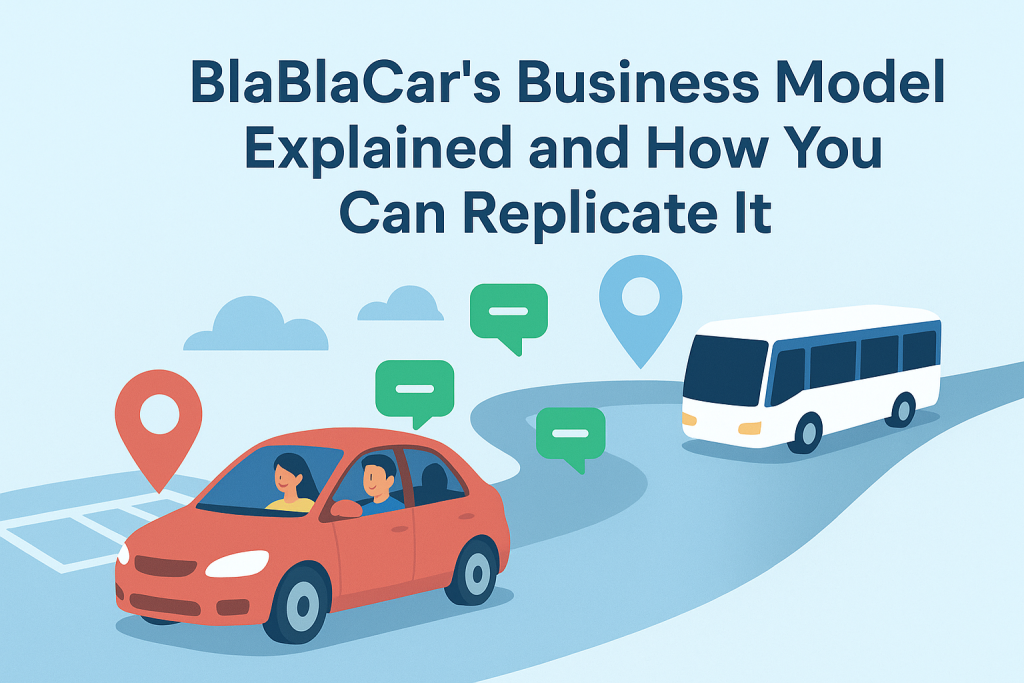
BlaBlaCar proved a simple but powerful idea: long-distance travel can be social, low-cost and efficient when drivers with spare seats can easily connect with passengers going the same way. The platform scaled rapidly by acting as an asset-light marketplace matching drivers and passengers, taking a small commission, and building trust with profiles and ratings. Today it’s a template for entrepreneurs who want to launch carpooling or multimodal mobility services.
Why the model works
There are three reasons BlaBlaCar found product-market fit: (1) cost efficiency sharing fuel and tolls beats buying a train ticket on many routes; (2) network effects more riders attract more drivers and vice versa; (3) trust mechanics reviews, verified IDs and rich profiles make strangers comfortable sharing a ride. The result is an experience that feels social rather than transactional.
How they make money
BlaBlaCar’s core revenue channel is transactional commissions on bookings (commonly reported in the high-teens percentage range), complemented by premium features, subscription tiers, and partnerships that broaden service offerings (e.g., bus ticketing after strategic acquisitions). That hybrid approach keeps the core marketplace attractive while opening higher-value revenue lines.
Product evolution: from carpooling to multimodal mobility
Instead of staying a single-feature app, BlaBlaCar expanded via acquisitions and new products adding buses, commuter carpooling and daily services so it could serve longer trips and regular commuters in the same ecosystem. That acquisition + integration playbook helped it cover more routes and increase booking density.
Building a BlaBlaCar-style Platform with ZyberTaxi (Uber Clone Script)
If you already have ZyberTaxi (an Uber clone script) as a starting point, you’re ahead: it typically includes ride booking, driver & rider apps, GPS routing, payments and an admin panel. To transform ZyberTaxi into a BlaBlaCar-style mobility marketplace, focus on these customizations:
- Add a Carpooling / Long-Distance Booking Module
- Extend ride types to include “Long-distance / Intercity” trips with scheduled departure times rather than on-demand pickups.
- Allow drivers to create trips (origin, destination, date/time, number of seats, stopovers) and set cost-sharing fares (with platform-enforced caps so drivers don’t profit beyond fuel/expense reimbursement).
- Marketplace Booking Flow & Commission Logic
- Modify payment routing so passengers pay through the platform and the driver receives the fare minus your commission (configurable per country/route).
- Add fare recommendation engines using historical route data to suggest fair prices and avoid extreme pricing.
- Profile & Trust Enhancements
- Enrich driver/rider profiles with identity verification, social links, photo galleries and “chat-level” preferences (quiet, chatty, etc.) so users can pick compatible travel companions.
- Keep 2-way ratings, mandatory reviews for completed trips, and an in-app dispute support queue.
- Scheduled Seat Reservations & Seat Management
- Implement seat inventory per trip (e.g., 4 seats available). Once seats are booked they’re held for a short window pending payment.
- Allow partial cancellations, pro-rated refunds, and conditional re-booking rules for drivers and passengers.
- Multimodal Expansion (Buses & Commuter Services)
- Add a “Bus Marketplace” plugin: bus operators can list routes and schedules, while your platform manages ticketing and seat maps.
- Add a recurring “Commuter Pass” feature for daily routes (similar to BlaBlaCar Daily) with subscription billing.
- Advanced Search & Matching
- Index trips by waypoints so riders can search for trips with flexible pick-up/drop-off points and filter by departure time, price, driver rating, and chat preference.
- Use simple matching algorithms initially; later add ML to predict popular routes and recommend drivers time slots to increase fill rates.
- Safety & Verification
- Integrate KYC (ID upload, liveness check), document validation for drivers, and emergency SOS features. Provide optional background checks if required by local law.
- Admin & Operations
- Extend the admin dashboard to monitor long-distance trip occupancy, revenue by route, cancellations, and refunds. Add tools to onboard bus operators or corporate commuter customers.
- Localization & Regulatory Readiness
- Make commission rates, pricing caps, and identity checks configurable per country/region to comply with local transportation rules and taxes.
- Add localized payment gateways, currency, and language support.
- Marketing & Growth Hooks
- Add referral bonuses for both drivers and riders, early-user discounts on new routes, and integration with campus or corporate programs to seed commuter services.
Final thoughts
Turning ZyberTaxi into a BlaBlaCar-style mobility marketplace is an exercise in product extension and trust engineering more than a complete rewrite. The heavy lifting is adding scheduled-trip flows, seat management, verified profiles, and the admin/operations tooling to manage multimodal inventory. Do those well and the asset-light marketplace model that made BlaBlaCar successful becomes repeatable: lower capex, stronger unit economics, and a service that people actually enjoy using.
